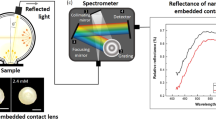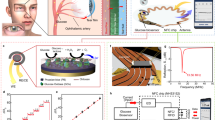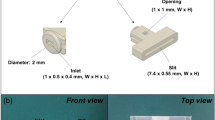Abstract
We have developed a range of disposable and colorless tear glucose sensing contact lenses, using off-the-shelf lenses embedded with new water soluble, highly fluorescent and glucose sensitive boronic acid containing fluorophores. The new lenses are readily able to track tear glucose levels and therefore blood glucose levels, which are ideally suited for potential use by diabetics. The fluorescence responses from the lenses can be monitored using simple excitation and emission detection devices. The novelty of our approach is two fold. Firstly, the notion of sensing extremely low glucose concentrations in tears, which track blood levels, by our contact lens approach, and secondly, the unique compatibility of our new glucose signaling probes with the internal mildly acidic contact lens environment. The new lenses are therefore ideal for the non-invasive and continuous monitoring of tear glucose, with about 15-min response time, and a measured shelf life in excess of 3 months. In this review article, we show that fluorescence based signaling using plastic disposable lenses, which have already been industrially optimized with regard to vision correction and oxygen/analyte permeability etc, may a notable alternative to invasive and random finger pricking, the most widely used glucose monitoring technology by diabetics.
Similar content being viewed by others
REFERENCES
Leonid Poretsky (Ed.) (2002). Principles of Diabetes Mellitus, Kluwer Academic/Plenum, Norwell, MA.
V. C. Medvei (1993). In The History of Clinical Endocrinology: A Comprehensive Account of Endocrinology from Earliest Times to Present Day, Parthenon, New York.
M. R. Robinson, R. P. Eaton, D. M. Haaland, G. W. Koepp, E. V. Thomas, B. R. Stallard, and P. L. Robinson (1992). Non-invasive glucose monitoring in diabetic patients: A preliminary evaluation. Clin. Chem. 38, 1618–1622.
H. M. Heise, R. Marbach, T. H. Koschinsky, and F. A. Gries (1994). Non-invasive blood glucose sensors based on near-infrared spectroscopy. Ann. Occup. Hyg. 18, 439–447.
W. F. March, B. Rabinovitch, R. Adams, J. R. Wise, and M. Melton (1982). Ocular Glucose sensor. Trans. Am. Soc. Artif. Intern. Organs 28, 232–235.
B. Rabinovitch, W. F. March, and R. L. Adams (1982).Non-invasive glucose monitoring of the aqueous humor of the eye, Part 1: Measurement of very small optical rotations.Diabetes Care 5,254–258.
G. M. Schier, R. G. Moses, I. E. T. Gan, and S. C. Blair (1988). An evaluation and comparison of reflolux Iiand Glucometer II, two new portable reflectance meters for capillary blood glucose determination. Diabetes Res. Clin. Pract. 4, 177–181.
W. Clarke, D. J. Becker, D. Cox, J. V. Santiago, N. H. White, J. Betschart, K. Eckenrode, L. A. Levandoski, E. A. Prusinki, L. M. Simineiro, A. L. Snyder, A. M. Tideman, and T. Yaegar (1988). Evaluation of a new system for self blood glucose monitoring. Diabetes Res. Clin. Pract. 4, 209–214.
W. Trettnak and O. S. Wolfbeis (1989). Fully reversible fiberoptic glucose biosensor based on the intrinsic fluorescence of glucose-oxidase. Anal. Chim. Acta 221, 195–203.
D. Meadows and J. S. Schultz (1988). Fiber optic biosensor based on fluorescence energy transfer. Talanta 35, 145–150.
L. Tolosa, H. Malak, G. Rao, and J. R. Lakowicz (1997). Optical assay for glucose based on the luminescence decay time of the long wavelength dye Cy5. Sens. Actuators B 45, 93–99.
L. Tolosa, I. Gryczynski, L. R. Eichorn, J. D. Dattelbaum, F. N. Castellano, G. Rao, and J. R. Lakowicz (1999). Glucose sensors for low cost lifetime-based sensing using a genetically engineered protein. Anal. Biochem. 267, 114–120.
S. D'Auria, N. Dicesare, Z. Gryczynski, I. Gryczynski, M. Rossi, and J. R. Lakowicz (2000). A thermophilic apoglucose dehydrogenase as a nonconsuming glucose sensor. Biochem. Biophys. Res. Commun. 274, 727–731.
R. Badugu, J. R. Lakowicz, and C. D. Geddes (2004). The noninvasive continuous monitoring of physiological glucose using a novel monosaccharide-sensing contact lens. Anal. Chem. 76, 610–618.
R. Badugu, J. R. Lakowicz, and C. D. Geddes (2003). A glucose sensing contact lens: A non-invasive technique for continuous physiological glucose monitoring.J. Fluorescence 13, 371–374.
C. D. Geddes, R. Badugu, and J. R. Lakowicz (2004). Contactlenses may provide window to blood glucose. Biophotoincs int. February(2), 50–53.
R. Badugu, J. R. Lakowicz, and C. D. Geddes (2004). Ophthalmic glucose sensing: A novel monosaccharide sensing disposable and colorless contact lens. The Analyst 129, 516–521.
J. M. Sugihara and C. M. Bowman (1958). Cyclic benzeneboronate esters.J. Am. Chem. Soc. 80(10), 2443–2446.
J. P. Lorand and J. O. Edwards (1959). Polyol complexes and structure of the benzeneboronate ion. J. Org. Chem. 24(6), 769–774.
G. Springsteen and B. Wang (2002). A detailed examination of boronic acid-diol complexation. Tetrahedron 58(26), 5291–5300.
T. D. James, K. R. A. S. Sandanayake, and S. Shinkai (1995). Chiral discrimination of monosaccharides using a fluorescent molecular sensor. Nature 374, 345.
J. C. Norrild and H. Eggert (1995). Evidence for monodentate and bidentate boronate complexes of glucose in the furanose form-Application of (1)J(C-C)-coupling-constants as a structural probe. J. Am. Chem. Soc. 117(5), 1479–1484.
H. Eggert, J. Frederiksen, C. Morin, and J. C. Norrild (1999).A new glucose-selective fluorescent bisboronic acid. First report of strong alpha-furanose complexation in aqueous solution at physiological pH.J. Org. Chem. 64(11),3846–3852.
W. Yang, H. He, and D. G. Drueckhammer (2001). Computerguided design in molecular recognition: Design and synthesis of a glucopyranose receptor. Angew. Chem. Int. Ed. 40(9), 1714–1718.
W.Wang, S. Gao, and B.Wang (1999). Building fluorescent sensors by template polymerization: The preparation of a fluorescent sensor for D-fructose. Org. Lett., 1(8), 1209–1212.
S. Gao, W.Wang, and B.Wang (2001). Building fluorescent sensors for carbohydrates using template-directed polymerizations. Bioorg. Chem. 29, 308–320.
J. J. Lavigne and E. V. Anslyn (1999). Teaching old indicators new tricks: A colorimetric chemosensing ensemble for tartrate/malate in beverages. Angew. Chem. Int. Ed. 38(24), 3666–3669.
J. Yoon and A. W. Czarnik (1992). Fluorescent chemosensors of carbohydrates. A means of chemically communicating the binding of polyols in water based on chelation-enhanced quenching. J. Am. Chem. Soc. 114, 5874–5875.
B. D. Smith, S. J. Gardiner, T. A. Munro, M. F. Paugam, and J. A. Riggs (1998). Facilitated transport of carbohydrates, catecholamines, and amino acids through liquid and plasticized organic membranes. J. Incl. Phenom. Mol. Recogn. Chem. 32, 121–131.
S. Soundararajan, M. Badawi, C. M. Kohlrust, and J. H. Hagerman (1989). Boronic acids for affinity-chromatography-spectral methods for determinations of ionization and diol-binding constants. Anal. Biochem. 178, 125–134.
T. D. James, K. R. A. S., and S. Shinkai (1994). A glucose-selective molecular fluorescence sensor. Angew, Chem. Int. Ed. 33(21), 2207–2209.
T. D. James, K. R. A. S. Sandanayake, R. Iguchi, and S. Shinkai (1995). Novel saccharide-photoinduced electron-transfer sensors based on the interaction of boronic acid and amine. J. Am. Chem. Soc. 117(35), 8982–8987.
N. Dicesare and J. R. Lakowicz (2001). Evaluation of two synthetic glucose probes for fluorescence-lifetime based sensing. Anal. Biochem. 294, 154–160.
N. Dicesare and J. R. Lakowicz (2001). Wavelength-ratiometric probes for saccharides based on donor-acceptor diphenylpolyenes. J. Photochem. Photobiol. A: Chem. 143, 39–47.
N. Dicesare and J. R. Lakowicz (2001). New color chemosensors for monosaccharides based on Azo dyes. Org. Lett. 3(24), 3891–3893.
N. Dicesare and J. R. Lakowicz (2002). Chalcone-analogue fluorescent probes for saccharides signaling using the boronic acid group. Tet. Lett. 43, 2615–2618.
. V.V. Karnati, X. Gao, S. Gao, W.Yang, W. Ni, S. Sankar, and B.Wang (2002). A glucose-selective fluorescence sensor based on boronic acid-diol recognition. Bioorg. Med. Chem. Lett. 12, 3373–3377.
N. Dicesare and J. R. Lakowicz (2002). Charge transfer fluorescent probes using boronic acids for monosaccharide signaling. J. Biomed. Opt. 7(4), 538–545.
R. Badugu, J. R. Lakowicz, and C. D. Geddes (manuscript submitted for publication). Fluorescence sensors for monosaccharides based on the 6-methylquinolinium nucleus and boronic acid moiety: Application to ophthalmic diagnostics. Talanta.
R. Badugu, J. R. Lakowicz, and C. D. Geddes (manuscript submitted for publication). Boronic acid fluorescent sensors for monosaccharide signaling based on the 6-methoxyquinolinium heterocyclic nucleus: Progress towards noninvasive and continuous glucose monitoring. Bioorg. Med. Chem.
J. R. Lakowicz (1997). Principles of Fluorescence Spectroscopy 2nd ed., Kluwer/Academic Plenum, New York.
N. J. Turro, B. H. Baretz, and P. I. Kuo (1984). Photoluminescence probes for the investigation of interactions between sodium dodecylsulfate and water-soluble polymers. Macromolecules 17(7), 1321–1324.
K. Kalyanasundaram and J. K. Thomas (1977). Environmental effects on vibronic band intensities in pyrene monomer fluorescence and their application in studies of micellar systems.J. Am. Chem. Soc. 99(7), 2039–2044.
N. Dicesare and J. R. Lakowicz (2001). Spectral properties of fluorophores combining the boronic acid group with electron donor or withdrawing groups. Implication in the development of fluorescence probes for saccharides. J. Phys. Chem. A 105(28), 6834–6840.
C. D. Geddes (2001). Optical halide sensing using fluorescence quenching: Theory, simulations and applications-A review. Meas. Sci. Tech. 12(9), R53.
O. S. Wolfbeis and E. Urbano (1982). J. Heterocyclic Chem. 19, 841–843.
C. D. Geddes, K. Apperson, J. Karolin, and D. J. S. Birch (2001). Chloride sensitive probes for biological applications. Dyes Pigments 48, 227–231.
M. A. Fox and M. Chanon (Eds.) (1998). Photoinduced Electron Transfer Parts A-D, Elsevier, New York.
G. J. Kavarnos (1993). Fundamentals of Photoinduced Electron Transfer VCH, New York.
N. J. Van Haeringen (1981). Climical biochemistry in tears. SurveyOphthalmol. 26(2), 84–96
N. Chandrasekharan and L. Kelly (2004). in C. D. Geddes and J. R. Lakowicz (Eds.), Reviews in Fluorescence 2003, Kluwer Academic/Plenum, New York.
Author information
Authors and Affiliations
Corresponding author
Rights and permissions
About this article
Cite this article
Badugu, R., Lakowicz, J.R. & Geddes, C.D. Ophthalmic Glucose Monitoring Using Disposable Contact Lenses—A Review. Journal of Fluorescence 14, 617–633 (2004). https://doi.org/10.1023/B:JOFL.0000039349.89929.da
Issue Date:
DOI: https://doi.org/10.1023/B:JOFL.0000039349.89929.da




